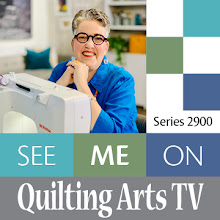 Stitch Sampler showing facing (back of quilt)Note: There are many methods for facing a quilt. This one is a combination of methods I learned from others, plus some tricks I learned while trying different techniques, and is the one that works best for me.
Stitch Sampler showing facing (back of quilt)Note: There are many methods for facing a quilt. This one is a combination of methods I learned from others, plus some tricks I learned while trying different techniques, and is the one that works best for me. This tutorial is available as a free four-page PDF – simply click
here, or go to the sidebar on the right side of this blog, scroll down to “Free Stuff” and click on the “How to face a quilt” link to download and print the PDF.
For this tutorial, I faced a small stitch sampler I created when preparing to film my DVD,
“Master Machine Quilting: Free-motion Stitching and Thread Sketching.” The back is black and the front is maroon. Normally I’d make the facing a color similar to the back of my quilt, or even the same fabric. In this case, I used white so you could see more clearly what I was doing.
I like to use this method on my art quilts; I think it makes them look more like art if they don’t have a traditional quilt binding. I have started using facings or a pillowcase turn on most of my art quilts, saving binding for my more traditional quilts.
DIRECTIONS:Trim your quilt, squaring up the corners, so that the backing and batting are even with the edge of the quilt.
Measure the width and length of your quilt and cut four 2" wide facing strips that are 2" longer than each side. (For example, if your quilt is 15" wide by 18" long, cut two facing strips 2" x 17" and two facing strips 2” x 20”.)
On one long edge of each strip, turn under and press under ¼".

Mark the width of the quilt side on the unfolded long edge of the first strip. Then measure in ¼" and make a second mark. Do the same at the other end. Pin the unfolded edge of the strip to the edge of the quilt, aligning the outer marks.


Using a standard presser foot or your walking foot, stitch along the edge between the two inner marks, back stitching at each end, with a ¼" seam allowance. Make sure to leave exactly ¼" at each end unstitched.

Fold back the facing strip.

Pin the next facing strip in place.

Stitch it down in the same way, with a ¼" seam allowance, back stitching at the two inner marks.

Apply all four sides in the same manner. Finger press the facings away from the quilt.

Fold each corner of the quilt at a 45° angle, with the front of the quilt inside, and align and pin the facing strips. Then use a ruler marked with a 45° angle and mark this angle on the facing strips.

The line should go from the end of the stitching at the inner mark at the corner of the quilt to the folded edge of the facing.

Stitch on this line, back stitching at each end, and stopping exactly at the place where this seam meets the seam where you sewed the facing to the quilt. Trim to a ¼" seam allowance.

Press the seam allowance open.

Clip corner and then grade seams near the corner. Do the other corners in the same manner.

Turn facing around to the back side of the quilt and finger press seams again. Use a blunt-tip tool to turn out corners.
From the front side, stitch along the edges about 1/8" from the seam, through the facing and the seam allowance. It is impossible to stitch around the corners; simply stitch up as far into the corners as you can. This seam, often used in garment construction, will help the facing turn more easily to the back.

Turn the facing to the back side of the quilt, and press it so that the facing does not show on the front. On the back, pin the facing to the backing.

Note: If the mitred seam (45° angle at the corners) does not fit snugly, you can tuck it under, pin it in place and stitch a tighter seam when you hand stitch the facing to the back in the next step.
Stitch the folded edge of the facing to the back of the quilt, tightening mitered seam if necessary.

Here is the back of the quilt with the white facing.


Here is a corner of the faced quilt from the front.

If you are curious about other facing methods, here are some great instructions:
Grace Howes
http://barnyardchatter.wordpress.com/2009/04/06/facings-an-alternative-to-traditional-bindings/Brenda Gael Smith
http://serendipitypatchwork.com.au/blog/2008/05/27/mitred-facing-tutorial/and
http://serendipitypatchwork.com.au/blog/2009/01/13/my-favourite-quilt-facing-finish/Jeri Riggs
http://jeririggs.blogspot.com/2008/02/facings-for-quilts.html









































































